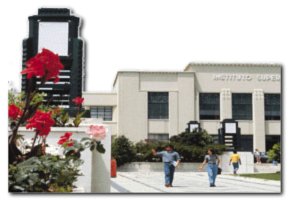IST, Lisbon and Portugal |
Sightseeing in Portugal
The conference will be held at the Congress Center of
Instituto Superior Tecnico
(IST), the School of Engineering of the Technical
University of Lisbon. IST is located in the Alameda Afonso Henriques, a few
kilometers from the Lisbon airport (Aeroporto da Portela), and five minutes walking from the closest
subway station,
Alameda.
Please find here maps and other important information for participants.
Where to eat close to IST
Close to Instituto Superior Técnico (IST) you will find many
places where you can eat. Some places are shown
here.
Social event – Conference Banquet
The banquet will be served at Estufa Real, a restaurant located in the Botanic Garden of
Ajuda that has a wonderfull view to the Tagus River. Designed in 1768 by the Italian botanist
Domingos Vandelli in royal service at the request of King D. José I, this was to become
the first botanic garden in Lisboa. The aim was to have the largest possible number of species
in a single garden, once reaching the 5000 species. Recently this greenhouse was turned into
a restaurant where menus are prepared following the changing of seasons.


IST, Lisbon and Portugal
About Instituto Superior Técnico - IST
|
The Instituto SuperiorTécnico (IST), created in 1911, is
one of the largest and most reputed schools of engineering, science
and technology in Portugal. |
 |
IST’s mission is to contribute to the development of society
by promoting a higher education of outstanding quality in the areas of
Engineering, Science and Technology, at undergraduate and postgraduate
levels, and by carrying out research and development activities in accordance
with the highest international standards. Its mission thus reflects the three
activities that define the concept of a modern university: Education,
Research &Development and Links with Society. |
|
Today IST offers 21 undergraduate programs, attended by more than 8600
students, covering a wide range of areas of knowledge, including not only
all the traditional engineering specializations, but also other modern areas
such as Biological Engineering, Aerospace and Physics Engineering. Postgraduate
training is also important with over 1500 students enrolled in 28 Master
programmes, 21 doctoral areas and various specialized courses. |
About Lisbon
|
Lisbon, with a population of about one million inhabitants (two million
in the metropolitan area), is the capital, the chief port and the
largest city of Portugal. It stands on the westernmost point of land of the European continent,
where the Tagus river flows into the Atlantic Ocean. Its climate is
probably the mildest of all European capitals. Lisbon is one of the most
ancient cities in the western Europe. Probably inhabited since the
Neolithic period, it was settled by Phoenicians in 1200 BC, who named it
Alis Ubbo (calm port). |
 |
 |
They prospered for more than 600 years until it was occupied by Greeks
and Carthaginians, then by the Romans in 205 BC, by the Barbarians in
the 5th century AC, by the Arabs in 715 AC, till it was finally conquered
by D. Afonso Henriques during the Crusades in 1147, and declared capital
of the Portuguese kingdom in 1252. The city name evolved with each new
occupant until its present form Lisboa. In the 15th and 16th centuries,
the Age of the Discoveries, Lisbon became the center of the world and
the entrance of Europe to the Oceans. |
| |
|
Being already an important city when conquered in 1147, it continued
growing its importance. In 1260 the King Afonso III transferred his
court there from Coimbra. The University of Lisbon was founded in 1292.
It is perhaps this long history of finding new lands and cultures that
explains why Lisboans are, by nature and tradition, open to the new and
very welcoming to visitors. Find
here more information about Lisbon. |
 |
About Portugal
 |
Portugal is located on the west side of the Iberian Peninsula,
along the Atlantic East coast. In its entirety, Portugal occupies an
area of about 92 000 km2, including the islands of Madeira and Azores,
in the Atlantic. Portugal has a population of about 10 million people.
The capital is Lisbon with a population of 1.5 million.
Known for its sunny beaches, Porto wine, or typical Fado music, Portugal
is a chosen destination for many holidaymakers, an ideal place for
practicing water sports and playing golf, offering modern tourism
facilities. A member-country of the European Union since 1986, it
currently enjoys a steady economic growth. For centuries Portugal has
kept this greatest treasure: a renowned reputation of hospitality that
makes the country a haven of congeniality and safety. |
The history of this geographical area is rather long, spanning from
the Palaeolithic period 7000 BC into the dawn of civilization. At the
end of the Neolithic period, starting 1200 BC and for almost 2500 years,
the Phoenicians, the Greeks, the Carthaginians, the Romans, the Visigoths
and the Arabs successively invaded and settled in the Iberian Peninsula.
The latter remained in control until the 11th century when Ferdinand,
ruler of the kingdom of Leon and Castile, conquered much of the
territory. An independent kingdom since 1143, Portugal established
its continental frontiers in 1297 and is one of the oldest nations
in Europe. Portugal became a major player in Europe at the age of the
discoveries in the 15th century, when it developed and mastered the
nautical science and discovered new lands, setting new trade routes
to as far as India and Japan.
Portugal became a republic on 5th October 1910 and is an established
democarcy today. In January of 1986 Portugal joined the European
Community. See more information in
Portugal.org, Portugal Online. |
 |
Lisbon
and the surroundings offer a great deal of tourist attractions:
|
|



